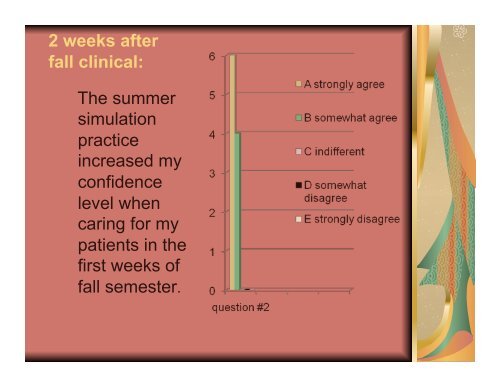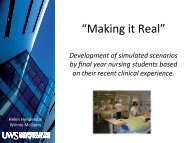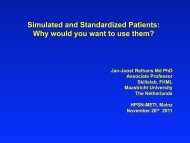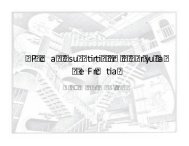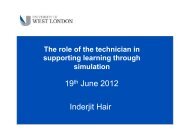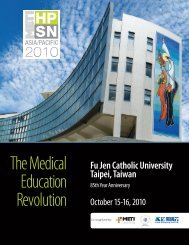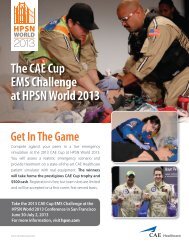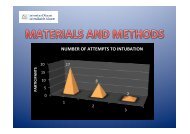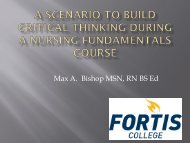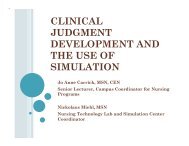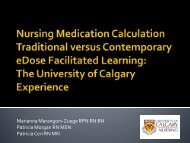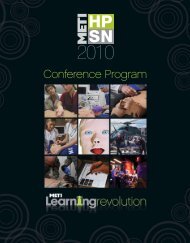Post-Simulation Evaluation
Post-Simulation Evaluation
Post-Simulation Evaluation
You also want an ePaper? Increase the reach of your titles
YUMPU automatically turns print PDFs into web optimized ePapers that Google loves.
2 weeks after<br />
fall clinical:<br />
The summer<br />
simulation<br />
practice<br />
increased my<br />
confidence<br />
level when<br />
caring for my<br />
patients in the<br />
first weeks of<br />
fall semester.
Immediately post scenario:<br />
The summer simulation practice will decrease my<br />
anxiety when returning to clinical this fall semester
2 weeks after<br />
fall clinical:<br />
The summer<br />
simulation<br />
practice<br />
decreased<br />
my anxiety<br />
level when<br />
returning to<br />
clinical this<br />
fall<br />
semester.
Students comments:<br />
! “ I enjoyed the mixed levels, it helped<br />
me to understand more about what I<br />
am going to be learning in the near<br />
future”<br />
! “Mixed levels is a great idea! Would<br />
even help during the semester”<br />
! “ I think they were very helpful; my<br />
only wish is that we could’ve had<br />
more simulations during break”
Extra Scenarios Offered:<br />
! Basic Assessment – Cardiac Patient<br />
6 students from Nursing II, III and IV attended.<br />
1) Demonstrate how to obtain a focused history of<br />
the cardiovascular (CV) system.<br />
2) Identify modifiable & non-modifiable risk factors.<br />
3) Demonstrates assessment findings in a patient<br />
with CV disease.<br />
4) Describe the nursing interventions for this<br />
patient.<br />
5) Describe the treatments and medications for this<br />
patient.
Basic Cardiac Assessment<br />
! Pre-Scenario <strong>Evaluation</strong><br />
History 3.6<br />
Risk Factors 4.0<br />
Assessment 4.0<br />
Nursing Interventions 3.2<br />
Treatments & Meds 3.0<br />
! <strong>Post</strong>-Scenario <strong>Evaluation</strong><br />
4.4<br />
4.8<br />
4.2<br />
4.4<br />
4.2<br />
Likert Scale of 1-5<br />
1= No confidence<br />
5=Feel very confident<br />
N =6
Fluid & Electrolytes / Dehydration<br />
! Pre-Scenario <strong>Evaluation</strong><br />
Pathology 3.6<br />
Lab Values 3.3<br />
Assessment 3.6<br />
Nursing Interventions 3.7<br />
Treatments & Fluids 3.4<br />
! <strong>Post</strong>-Scenario <strong>Evaluation</strong><br />
4.3<br />
4.5<br />
4.6<br />
4.6<br />
4.4<br />
N=10
Foreign Body Airway<br />
Obstruction<br />
! Pre-Scenario <strong>Evaluation</strong><br />
Define FAO 3.3<br />
Identify methods and diagnosis of<br />
FAO 2.5<br />
Discuss teaching & discharge<br />
instructions 3.3<br />
Describe nursing interventions<br />
3.3<br />
Evaluate the patient’s response<br />
to nursing interventions and<br />
treatments 3.3<br />
! <strong>Post</strong>-Scenario <strong>Evaluation</strong><br />
4.5<br />
4.5<br />
4.3<br />
4.5<br />
4.5<br />
N=4
<strong>Post</strong> Op Ileus<br />
! Pre-<strong>Simulation</strong> <strong>Evaluation</strong><br />
Assessment 3.7<br />
! <strong>Post</strong>-<strong>Simulation</strong> <strong>Evaluation</strong><br />
4.0<br />
Nursing & Medical Management<br />
3.4<br />
4.0<br />
Pathology 3.4<br />
Nursing Interventions 3.7<br />
Response to interventions 3.4<br />
Lab Values 3.4<br />
4.0<br />
4.0<br />
5.0<br />
5.0<br />
N = 3
Chemotherapy Patient<br />
! Pre-Scenario <strong>Evaluation</strong><br />
Physical assessment/<br />
complications 1.0<br />
Pathology 1.5<br />
Assessment Findings 1.5<br />
Nursing Interventions 1.0<br />
Treatments 1.0<br />
Lab Values 1.0<br />
! <strong>Post</strong>-Scenario <strong>Evaluation</strong><br />
3.5<br />
3.5<br />
4.0<br />
4.0<br />
4.0<br />
4.0<br />
N=2
All Scenario’s <strong>Post</strong> – <strong>Evaluation</strong><br />
! Included these questions:<br />
5 point Likert scale utilized for analysis.<br />
1=Strongly disagree 5= Agree strongly<br />
I feel this simulation was beneficial.<br />
I feel the scenarios were realistic and applicable to<br />
my learning needs.<br />
I felt anxious during the simulation.<br />
I feel that my anxiety interfered with my learning.
Results<br />
! Fluid & Electrolytes/Dehydration<br />
All students identified that their anxiety was<br />
not an issue in this simulation 3.1/5.0 with 3<br />
being neither agree or disagree.<br />
They ranked scenario realism at 4.8/5.0<br />
They ranked the benefit that this scenario<br />
had on their learning at 4.8/5.0<br />
They ranked their anxiety as interfering with<br />
their learning as 2.3/5.0 with 2 = disagree<br />
with the statement and 5 = strongly agree .
Results
Results
Plans for the Future<br />
! Continue offering extra simulation<br />
scenarios during school year<br />
! Start a “Summer <strong>Simulation</strong> Camps”<br />
! NCLEX review with simulation for<br />
graduates prior to NCLEX exam<br />
! Reviewer camps as a refresher course for<br />
Alumni who are returning to nursing<br />
! Continue to collect data and publish<br />
research on effectiveness of simulation for<br />
student learning.
What do you think<br />
! What are your thoughts<br />
! Has anyone tried extra simulation<br />
scenarios<br />
! How is simulation being used in your<br />
curriculum<br />
! How can we evaluate the<br />
effectiveness of simulation in the<br />
learning process
References<br />
! National League for Nursing. (2004).<br />
Innovation in nursing education: A call<br />
to reform. New York: National League<br />
for Nursing.<br />
! Del Bueno, D. J. (2004). A crisis in<br />
critical thinking. Nursing Education<br />
Perspectives, 26 (5). 278-283.
References<br />
! Clarke, S.P., & Aiken, L.H. (2003).<br />
Failure to rescue: Needless deaths<br />
are prime examples of the need for<br />
nurses at the bedside. American<br />
Journal of Nursing. 103(1), 42-47.<br />
! Linden L.L., (2008) The Effect of<br />
Clinical <strong>Simulation</strong> and Traditional<br />
Teaching Versus Traditional Teaching<br />
Alone on Critical Thinking of Nursing<br />
Students. EdD thesis, College of<br />
Saint Mary, Omaha, NE.
References Continued<br />
! Kolb, D. A., (1984). Experiential<br />
learning: Experience as the source of<br />
learning and development. NJ:<br />
Prentice-Hall<br />
! Benner, P. (1984). From Novice to<br />
Expert Excellence and Power in<br />
Clinical Nursing Practice. Don Mills,<br />
Ontario: Addison-Wesley Publishing<br />
Company
References Continued<br />
! Jeffries, P.R. (Ed.) (2007). <strong>Simulation</strong><br />
in Nursing Education From<br />
Conceptualization to <strong>Evaluation</strong>. New<br />
York, New York. National League for<br />
Nursing<br />
! Cant R.P. & Cooper S.J. (2010)<br />
<strong>Simulation</strong>-based learning in nurse<br />
education: systematic review. Journal<br />
of Advanced Nursing 66(1), 3-15.


